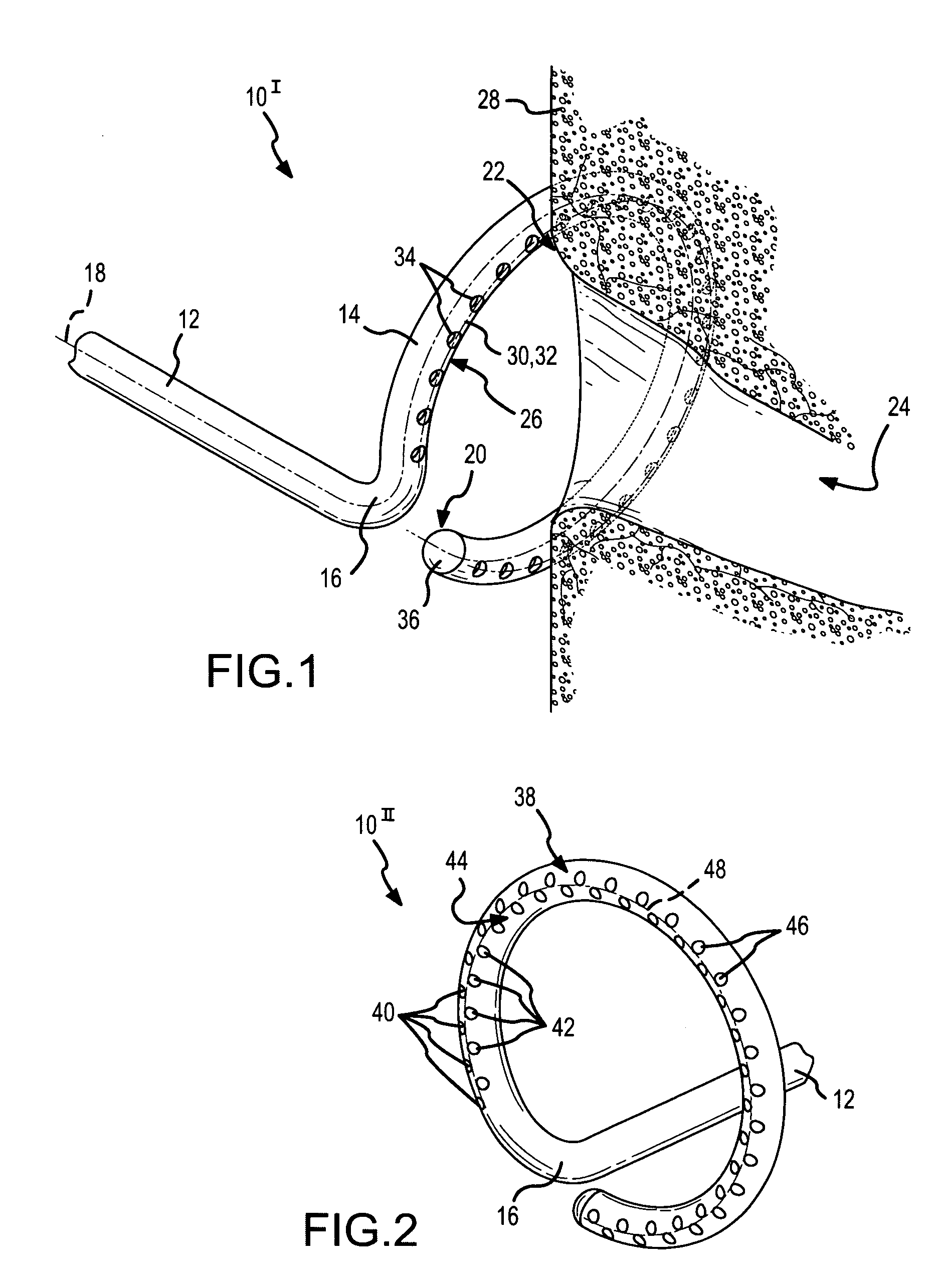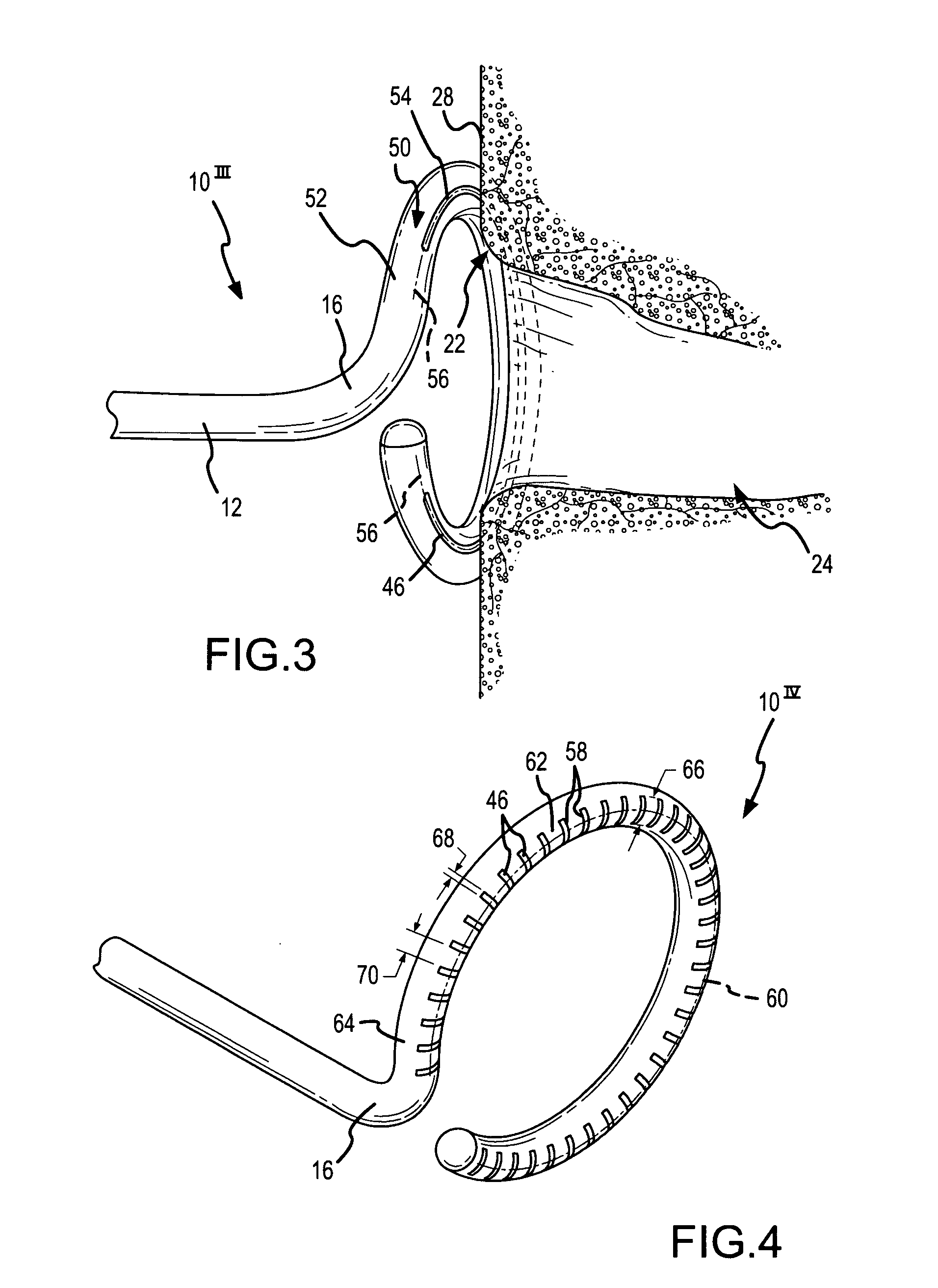Treatment and diagnostic catheters with hydrogel electrodes
a technology of hydrogel electrodes and catheters, applied in the field of hydrogel electrode catheters, can solve the problems of large temperature gradients and hot spots, affecting the treatment effect, and forming undesirable coagulum and surface tissue charring,
- Summary
- Abstract
- Description
- Claims
- Application Information
AI Technical Summary
Problems solved by technology
Method used
Image
Examples
first embodiment
[0045]FIG. 1 is a fragmentary, isometric view of the distal portion 10I of an ablation catheter according to the present invention. In this embodiment, the distal portion 10I of the ablation catheter comprises a straight section 12 and a curved or hoop-shaped section 14 that are joined at a bend or offset 16. A longitudinal axis 18 extends through both the straight section 12 and the curved section 14. As used herein, the term “longitudinal axis” refers to the longitudinal axis extending through the straight section 12 and through the curved section 14 of the ablation catheter, from the proximal end (not shown) of the catheter to the distal end 20 of the ablation catheter. The curved or hoop-shaped section 14 is C-shaped as shown, but may define a completely circular configuration rather than the open, C-shape depicted in FIG. 1. The bend or offset 16 may be formed or configured as shown in FIG. 1, wherein the offset displaces the straight section 12 of the catheter to the side, cau...
fourth embodiment
[0050]FIG. 4 is a fragmentary, isometric view of the distal portion 10IV of an ablation catheter according to the present invention. The embodiment depicted in FIG. 4 is similar to the embodiments depicted in FIGS. 1-3, except for the hydrogel deployment feature. In FIG. 4, the conductive hydrogel 46 is deployed or delivered through the catheter and against the tissue 28 being ablated via a plurality of laterally-extending or transversely-extending hydrogel slots 58. These laterally-extending hydrogel slots 58 extend substantially perpendicularly to the arc or line defining a slot centerline 60 along the radial apex of the distally-facing surface 62 of the curved section 64 of the ablation catheter. The transverse length 66 of each hydrogel slot 58 may be adjusted to obtain the desired lesion width. The longitudinal width 68 of each hydrogel slot 58 as well as the separation distance 70 between adjacent slots may be adjusted to control potential gaps in the arcuate lesion formed dur...
fifth embodiment
[0051]FIGS. 5-7 are fragmentary views of the distal portion 10V of an ablation catheter according to the present invention. In the embodiment depicted in FIGS. 5-7, the hydrogel deployment feature comprises a plurality of hydrogel portholes 72 arranged along a single row, similar to the plurality of portholes 34 depicted in FIG. 1. In the embodiment of FIGS. 5-7, however, the single row of hydrogel portholes 72 is present along a porthole centerline 74 on the radial apex of an outer peripheral wall 76 of the curved section 78 rather than being on the radial apex 30 of the distally-facing surface 26 as shown in FIG. 1. In other words, the ablation catheter depicted in FIGS. 5-7 comprises an inner peripheral wall 80 and an outer peripheral wall 76 on the hoop-shaped or curved section 78, and the portholes 72 extend substantially radially through the outer peripheral wall 76 of this C-shaped or hoop-shaped curved section 78 of the ablation catheter.
[0052]FIG. 6 is a fragmentary, end vi...
PUM
 Login to View More
Login to View More Abstract
Description
Claims
Application Information
 Login to View More
Login to View More - R&D
- Intellectual Property
- Life Sciences
- Materials
- Tech Scout
- Unparalleled Data Quality
- Higher Quality Content
- 60% Fewer Hallucinations
Browse by: Latest US Patents, China's latest patents, Technical Efficacy Thesaurus, Application Domain, Technology Topic, Popular Technical Reports.
© 2025 PatSnap. All rights reserved.Legal|Privacy policy|Modern Slavery Act Transparency Statement|Sitemap|About US| Contact US: help@patsnap.com



